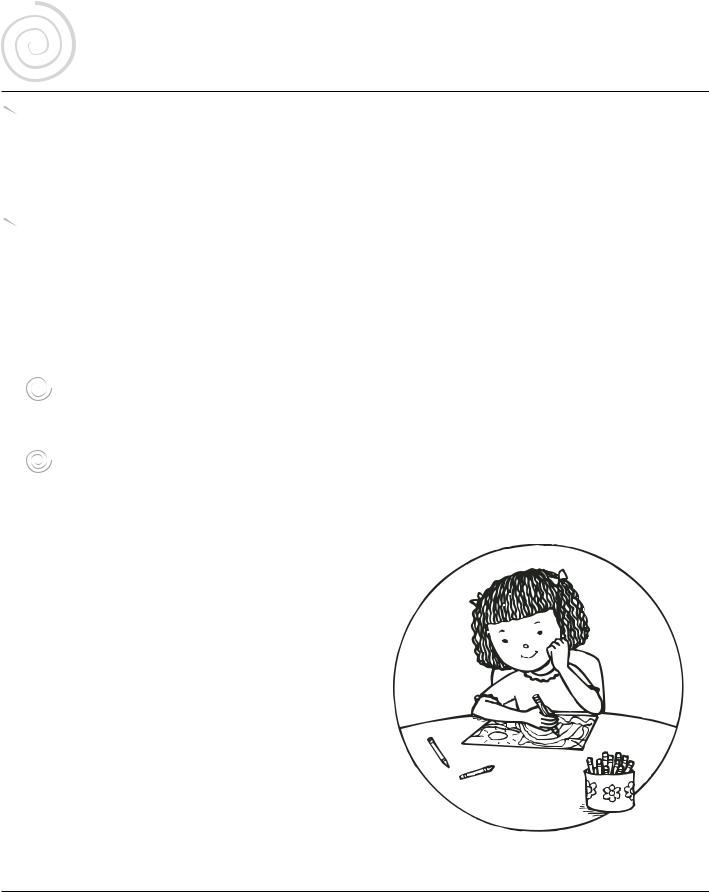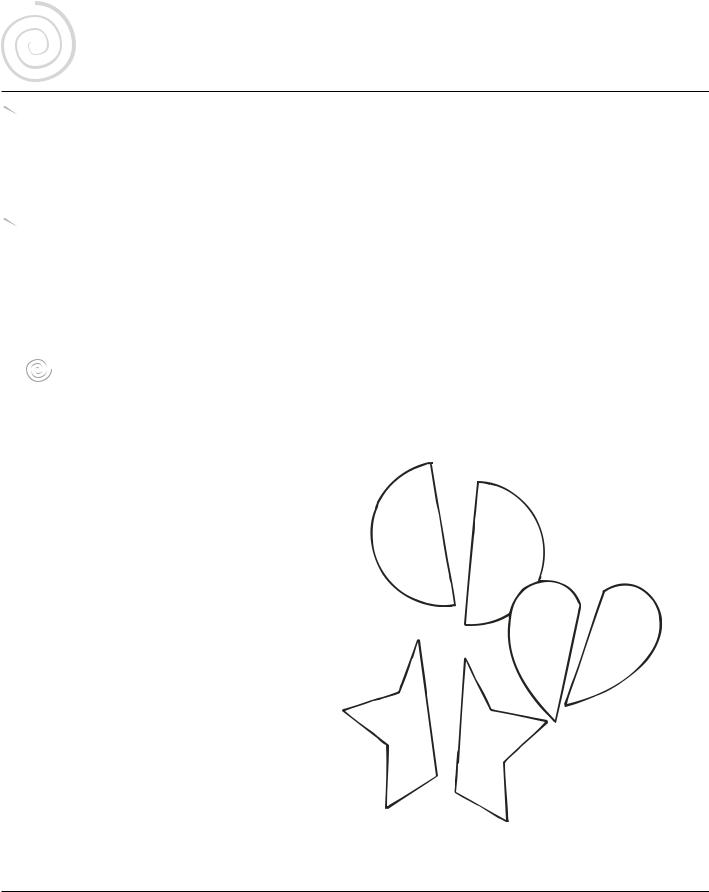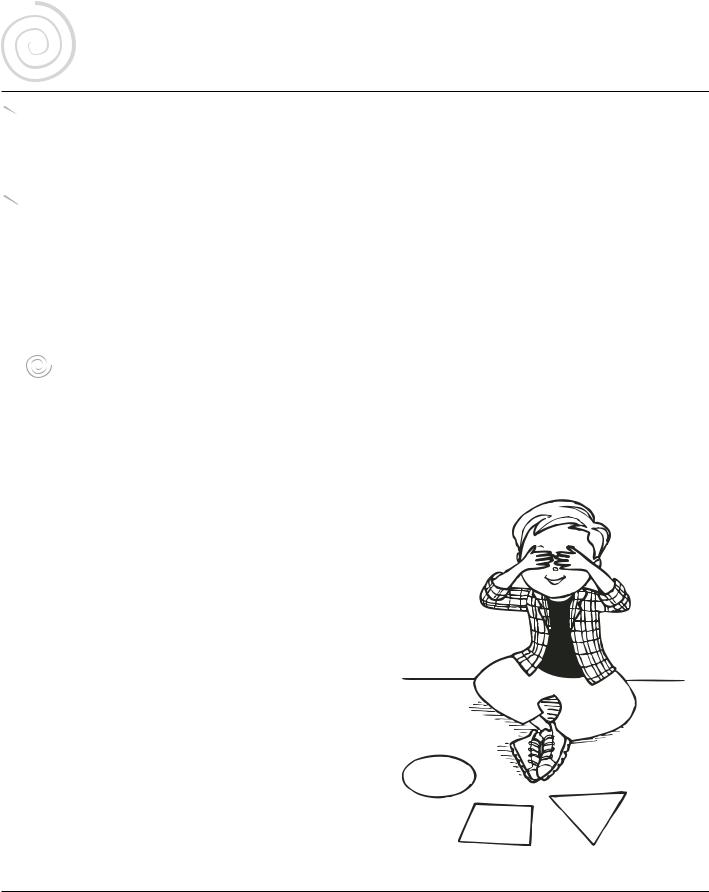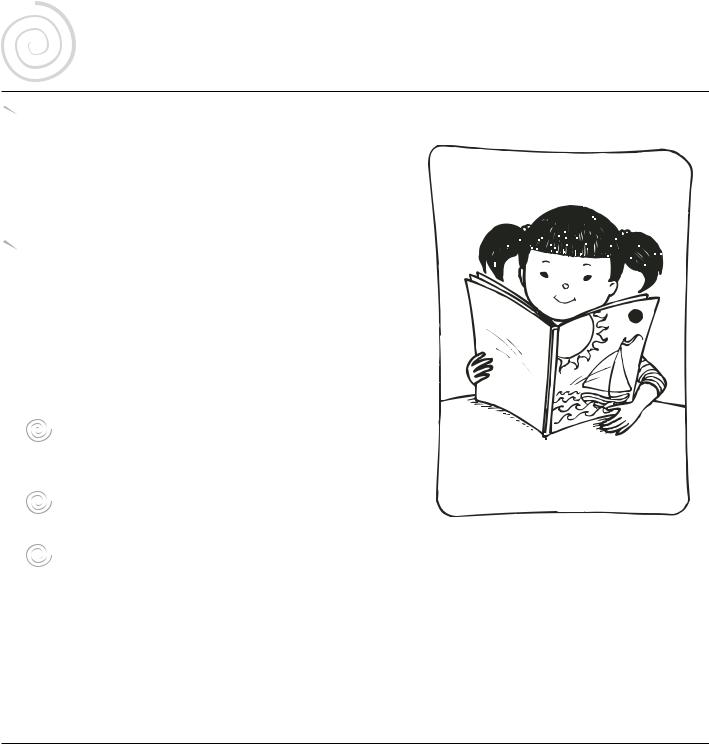
- •Table of Contents
- •Early Childhood Standards Correlation
- •Introduction
- •Crayon Poster
- •Shape Sandwiches
- •Here’s My Shape
- •Color Day
- •Breakfast Talk
- •Colorful Feelings
- •Find a Partner
- •Name the Missing Shape
- •Language and Literacy
- •The Story of a Circle
- •Anytime Egg Hunt
- •Who Can Find It?
- •Parking Garage
- •Scarf Pull
- •There’s a Word for That
- •Wheel Walk
- •Color Story
- •Big Book Time
- •Color Journal
- •Math
- •Green Things
- •In the Doghouse
- •Colorful Block Tower
- •Flannelboard Train
- •Match It
- •Paint Sample Matching
- •Block Play
- •Circle Sort
- •Secret Shapes
- •Take-Home Flannelboard Kit
- •Sandpaper Shapes
- •Shape Picture Cards
- •Shoe Sort
- •Treasure Maps
- •Neighborhood Picture Book
- •Do What I Do
- •Science
- •Food Color Chart
- •Shaker Bottle
- •Something Blue
- •Apple Exploration
- •Make a Rainbow
- •Bubbles Everywhere
- •Studying Leaves
- •Mixing Tints
- •Color Goo
- •Rainbow Pudding
- •Light Show
- •Rolling Along
- •Sun Prints
- •Tinted Ice Cubes
- •Music and Movement
- •Some Shoes
- •Color Train
- •Flag March
- •If Your Clothes Have Any Red
- •Here We Go
- •Do You Know What Shape This Is?
- •Color Binoculars
- •Red Light, Green Light
- •Body Shapes
- •Read the Notes
- •Circle Gets the Square
- •The Shapes Are on the Floor
- •Visual Arts
- •Recycled Rainbow
- •Shape Prints
- •Counting Collage
- •Marvelous Mobiles
- •Shape Flags
- •Shape Mural
- •Craft Stick Shapes
- •Motor Mural
- •Paper Bag Puppets
- •Bubbly Paint
- •Sun Catcher
- •Colored Sand
- •My Own Color Banner
- •Dramatic Play
- •Blanket Fold
- •Under the Sea
- •Color Photography
- •The Ice Cream Shop
- •Special Delivery
- •The Flower Market
- •Motor Skills
- •Get Into Shape
- •Just Like Me
- •Out the Door
- •Color Thumbkin
- •Shape Toss
- •Finger Dance
- •Moving Shapes
- •Roll a Triangle
- •Nail Shapes
- •Color Matching Board
- •Connect the Colors
- •I Can Make a Circle
- •Shape Sewing Cards
- •Rainbow Fruit Salad
- •String Shapes
- •Dough Shapes
- •Color Mixing
- •Pom-Pom Sort

Social and Emotional Development
6 COLORFUL FEELINGS
 Materials
Materials
Art books or postcards
Paper
Drawing supplies
 Activity
Activity
Provide examples of abstract or impressionist art for the children to examine. (The works of Kandinsky and Monet are good choices.) Ask, How do the shapes and colors make you feel? Do some colors make you feel happy? Do some colors make you feel sad? Then sit with a small group of children at the art center. Ask them what colors they would use to express their own feelings. What color is happiness? Sadness? Anger? Frustration? Silliness? Let each child select a crayon or marker and draw a “Happy Picture,” or a picture depicting any other emotion. Make a gallery of colorful feelings pictures for all to enjoy.
Variation: Instead of showing the children abstract art, play a recording of instrumental music to set the tone for their drawings. You might choose “The Flight of the Bumblebee,” or a selection from
Peter and the Wolf, Sleeping Beauty, or The Carnival of the Animals.
Tip: If one of the children is finding it difficult to express emotions in an appropriate manner, try letting him or her sit in a quiet place with some art supplies. Many children find drawing to be a soothing activity and some are able to draw more easily than they can speak.
© School Specialty Publishing |
11 |
1-57029-487-9 101 Colors and Shapes Activities |
M Graw-Hill Chi dren’s |

Social and Emotional Development
7 FIND A PARTNER
 Materials
Materials
Construction Paper
Scissors
Large envelope
 Activity
Activity
Cut an assortment of shapes, such as circles, squares, triangles, hearts, and stars out of construction paper. Then cut each shape in half to make a two-piece puzzle. Mix up the shapes and put them into a large envelope. Let the children take turns selecting a shape from the envelope. (No peeking!) When everyone has chosen a puzzle piece, have the children put the pieces together. Children with matching puzzle pieces can be partners for the next activity.
Extension: For older children, make the same puzzle in multiple colors. Challenge the children to find the child whose puzzle piece matches theirs in both color and shape. For extra challenge, cut the puzzle shapes into three or four pieces.
© School Specialty Publishing |
12 |
1-57029-487-9 101 Colors and Shapes Activities |
M Graw-Hill Chi dren’s |

Social and Emotional Development
8 NAME THE MISSING SHAPE
 Materials
Materials
Construction paper
Scissors
 Activity
Activity
This small-group game is an easy way to assess children’s knowledge of shapes. Ahead of time, cut four different shapes from the same color of construction paper. Invite a small group of children to sit with you in a circle. Have them look at the shapes and then have them close their eyes as you remove one shape from the circle. Can the remaining children tell which shape is missing? Once children are familiar with the game, let them take turns hiding the shapes. Call on individuals to name the missing shapes. Continue until all players have had a chance to hide and name the shapes.
Variation: To make this a color game, use the same shape in four different colors. Ask the children to tell which color is missing from the set. For additional challenge, set out an assortment of shapes in a variety of colors. Remove one shape from the group and ask the children to recall both the name and the color of the missing shape.
© School Specialty Publishing |
13 |
1-57029-487-9 101 Colors and Shapes Activities |
M Graw-Hill Chi dren’s |

CHAPTER 2
Language and Literacy
9 THE STORY OF A CIRCLE
 Materials
Materials
Old magazines
Scissors
Clear-plastic page protectors
Self-stick dots
 Activity
Activity
Cut interesting full-page pictures from magazines. Insert each picture in a clear-plastic page protector. Add a self-stick circle (available where office supplies are sold) on each page. Let the children take turns investigating the book. They will enjoy finding the circle on each page and making up stories about its adventures. Encourage the children to share their stories with friends and family.
Hint: Homemade books are perfect for extending themes. Keep a supply of old magazines on hand for making additions to your classroom library.
Variation: Draw faces on the self-stick dots to introduce a variety of circle characters.
Another Idea: Use photographs of the children in your group as the background for your book. A digital camera is useful for taking candid shots of children as they are engaged in daily activities or special events.
© School Specialty Publishing |
14 |
1-57029-487-9 101 Colors and Shapes Activities |
M Graw-Hill Chi dren’s |
